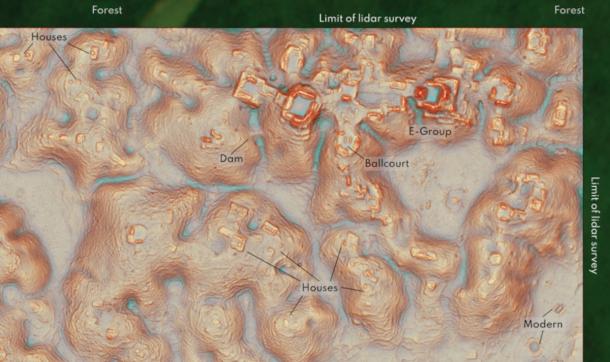🔴 Website 👉 https://u-s-news.com/
Telegram 👉 https://t.me/usnewscom_channel
Archaeologists analyzing lidar data from over the remote forests of Campeche, Mexico, have discovered a profusion of previously unknown Maya structures, including pyramids, residential complexes, and even an entire city. The conclusion is, we are nowhere near finding all the major Maya cities.
The findings, published in Antiquity, reveal a complex network of Maya civilization in a region that had, until now, been a practically a blank spot on archaeologists’ maps. This breakthrough challenges previous estimates of Maya urban density and suggests that much more of the Maya world remains hidden beneath Mexico’s dense tropical forests.
“For the longest time, our sample of the Maya civilization was a couple of hundred square kilometers total,” explained Luke Auld-Thomas, lead author and researcher at Northern Arizona University.
“That sample was hard-won by archaeologists who painstakingly walked over every square meter, hacking away at the vegetation with machetes, to see if they were standing on a pile of rocks that might have been someone’s home 1,500 years ago.”
Now, lidar technology is enabling scientists to scan these expansive regions from afar, uncovering evidence of structures ranging from small family dwellings to monumental pyramids akin to those found at iconic sites like Chichén Itzá and Tikal.
Lidar map of one of the sites discovered, indicating buildings such as houses and a ballcourt. (Luke Auld-Thomas/Antiquity Publications Ltd)
Rediscovering a Maya City Hidden in Plain Sight
The breakthrough began with an innovative approach to analyzing lidar data. Because lidar surveys are often prohibitively expensive, archaeologists must prioritize areas where Maya settlements are already known to exist. However, Auld-Thomas and his team realized they could use data from a 2013 lidar survey initially commissioned for monitoring carbon levels in Mexican forests.
With this data, collected by a consortium of environmental scientists, Auld-Thomas collaborated with Tulane University, Mexico’s Instituto Nacional de Antropología e Historia, and the University of Houston’s National Center for Airborne Laser Mapping to survey 50 square miles of untouched land in Campeche.
This re-purposed data revealed 6,674 Maya structures previously unknown to the archaeological community. The sheer number and variety of structures mapped in the Campeche region confirmed that this area had been far from a rural outpost; instead, it was densely populated with villages, ceremonial complexes, and, most astonishingly, a major city.
“We didn’t just find rural areas and smaller settlements,” Auld-Thomas said. “We also found a large city with pyramids right next to the area’s only highway, near a town where people have been actively farming among the ruins for years. The government never knew about it; the scientific community never knew about it. That really puts an exclamation point behind the statement that, no, we have not found everything, and yes, there’s a lot more to be discovered.”
Ancient buildings clustered on a hilltop revealed by narrow transept of lidar survey, while at modern satellite image reveals modern agriculture and road building. (Luke Auld-Thomas/Antiquity Publications Ltd)
Ancient Maya Urban Diversity: New Insights for Modern Cities
As research continues, Auld-Thomas and his team believe that the study of these Maya urban plans could have practical applications in modern urban planning, especially for areas experiencing rapid population growth. The ancient Maya, known for their adaptability and innovation in urban design, created cities that varied widely, with some regions featuring sprawling, agriculture-friendly designs and others exhibiting densely packed urban centers.
“The ancient world is full of examples of cities that are completely different than the cities we have today,” said Auld-Thomas.
“There were cities that were sprawling agricultural patchworks and hyper-dense; there were cities that were highly egalitarian and extremely unequal. Given the environmental and social challenges we’re facing from rapid population growth, it can only help to study ancient cities and expand our view of what urban living can look like.”
For modern urban developers, the discovery offers an invaluable resource—a “longer record of the accumulated residue of people’s lives” that could help inspire sustainable, inclusive city planning today. The variety of Maya urban designs, some egalitarian and others highly stratified, provides a vast array of models for accommodating population density while addressing social equity and resource management. These insights are particularly valuable as cities today grapple with issues like land scarcity, infrastructure strain, and environmental impact.
A New Chapter in Maya Archaeology
This discovery reopens the question of how much remains to be discovered in the Maya world. While scholars have studied Maya civilization for more than a century, only a fraction of their cities have been uncovered. “Our analysis not only revealed a picture of a region that was dense with settlements, but it also revealed a lot of variability,” explained Auld-Thomas. These findings strengthen the idea that Maya civilization was far more extensive and complex than previously assumed, with interconnected settlements stretching across vast territories in Central America and Mexico.
Fieldwork will begin soon at the newly identified sites, as archaeologists seek to learn more about the daily lives, cultural practices, and architectural techniques of the Maya who inhabited this once-bustling city. This work, they hope, will continue to piece together the untold stories of one of the world’s most fascinating civilizations.
Top image: Ancient buildings and landscape modifications (including public plazas, agricultural terraces, and field walls) blanket uplands, while low-lying areas that flood seasonally were mostly unmodified save for the construction of reservoirs. Source: Luke Auld-Thomas/Antiquity Publications Ltd
By Gary Manners
